Nuno M. Guerreiro
EuroLLM-9B: Technical Report
Jun 04, 2025Abstract:This report presents EuroLLM-9B, a large language model trained from scratch to support the needs of European citizens by covering all 24 official European Union languages and 11 additional languages. EuroLLM addresses the issue of European languages being underrepresented and underserved in existing open large language models. We provide a comprehensive overview of EuroLLM-9B's development, including tokenizer design, architectural specifications, data filtering, and training procedures. We describe the pre-training data collection and filtering pipeline, including the creation of EuroFilter, an AI-based multilingual filter, as well as the design of EuroBlocks-Synthetic, a novel synthetic dataset for post-training that enhances language coverage for European languages. Evaluation results demonstrate EuroLLM-9B's competitive performance on multilingual benchmarks and machine translation tasks, establishing it as the leading open European-made LLM of its size. To support open research and adoption, we release all major components of this work, including the base and instruction-tuned models, the EuroFilter classifier, and the synthetic post-training dataset.
Zero-shot Benchmarking: A Framework for Flexible and Scalable Automatic Evaluation of Language Models
Apr 01, 2025Abstract:As language models improve and become capable of performing more complex tasks across modalities, evaluating them automatically becomes increasingly challenging. Developing strong and robust task-specific automatic metrics gets harder, and human-annotated test sets -- which are expensive to create -- saturate more quickly. A compelling alternative is to design reliable strategies to automate the creation of test data and evaluation, but previous attempts either rely on pre-existing data, or focus solely on individual tasks. We present Zero-shot Benchmarking (ZSB), a framework for creating high-quality benchmarks for any task by leveraging language models for both synthetic test data creation and evaluation. ZSB is simple and flexible: it requires only the creation of a prompt for data generation and one for evaluation; it is scalable to tasks and languages where collecting real-world data is costly or impractical; it is model-agnostic, allowing the creation of increasingly challenging benchmarks as models improve. To assess the effectiveness of our framework, we create benchmarks for five text-only tasks and a multi-modal one: general capabilities in four languages (English, Chinese, French, and Korean), translation, and general vision-language capabilities in English. We then rank a broad range of open and closed systems on our benchmarks. ZSB rankings consistently correlate strongly with human rankings, outperforming widely-adopted standard benchmarks. Through ablations, we find that strong benchmarks can be created with open models, and that judge model size and dataset variety are crucial drivers of performance. We release all our benchmarks, and code to reproduce our experiments and to produce new benchmarks.
Adding Chocolate to Mint: Mitigating Metric Interference in Machine Translation
Mar 11, 2025Abstract:As automatic metrics become increasingly stronger and widely adopted, the risk of unintentionally "gaming the metric" during model development rises. This issue is caused by metric interference (Mint), i.e., the use of the same or related metrics for both model tuning and evaluation. Mint can misguide practitioners into being overoptimistic about the performance of their systems: as system outputs become a function of the interfering metric, their estimated quality loses correlation with human judgments. In this work, we analyze two common cases of Mint in machine translation-related tasks: filtering of training data, and decoding with quality signals. Importantly, we find that Mint strongly distorts instance-level metric scores, even when metrics are not directly optimized for -- questioning the common strategy of leveraging a different, yet related metric for evaluation that is not used for tuning. To address this problem, we propose MintAdjust, a method for more reliable evaluation under Mint. On the WMT24 MT shared task test set, MintAdjust ranks translations and systems more accurately than state-of-the-art-metrics across a majority of language pairs, especially for high-quality systems. Furthermore, MintAdjust outperforms AutoRank, the ensembling method used by the organizers.
EuroBERT: Scaling Multilingual Encoders for European Languages
Mar 07, 2025Abstract:General-purpose multilingual vector representations, used in retrieval, regression and classification, are traditionally obtained from bidirectional encoder models. Despite their wide applicability, encoders have been recently overshadowed by advances in generative decoder-only models. However, many innovations driving this progress are not inherently tied to decoders. In this paper, we revisit the development of multilingual encoders through the lens of these advances, and introduce EuroBERT, a family of multilingual encoders covering European and widely spoken global languages. Our models outperform existing alternatives across a diverse range of tasks, spanning multilingual capabilities, mathematics, and coding, and natively supporting sequences of up to 8,192 tokens. We also examine the design decisions behind EuroBERT, offering insights into our dataset composition and training pipeline. We publicly release the EuroBERT models, including intermediate training checkpoints, together with our training framework.
Translate Smart, not Hard: Cascaded Translation Systems with Quality-Aware Deferral
Feb 18, 2025Abstract:Larger models often outperform smaller ones but come with high computational costs. Cascading offers a potential solution. By default, it uses smaller models and defers only some instances to larger, more powerful models. However, designing effective deferral rules remains a challenge. In this paper, we propose a simple yet effective approach for machine translation, using existing quality estimation (QE) metrics as deferral rules. We show that QE-based deferral allows a cascaded system to match the performance of a larger model while invoking it for a small fraction (30% to 50%) of the examples, significantly reducing computational costs. We validate this approach through both automatic and human evaluation.
Analyzing Context Contributions in LLM-based Machine Translation
Oct 21, 2024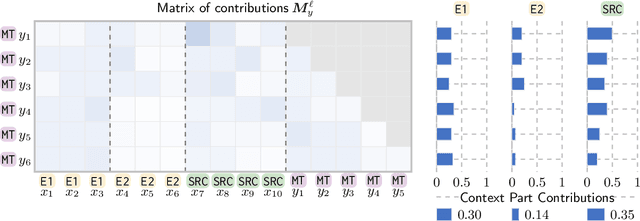
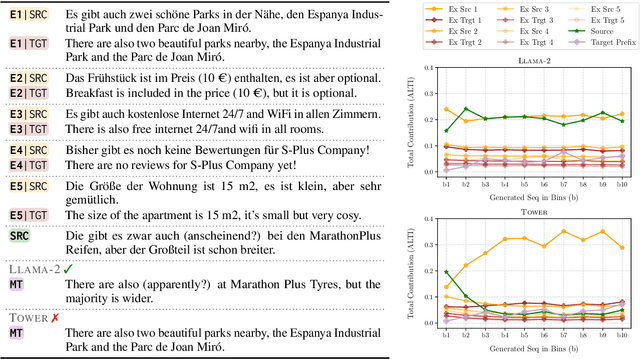
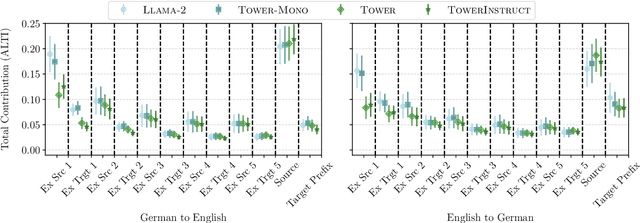
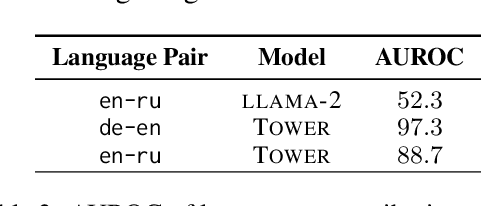
Abstract:Large language models (LLMs) have achieved state-of-the-art performance in machine translation (MT) and demonstrated the ability to leverage in-context learning through few-shot examples. However, the mechanisms by which LLMs use different parts of the input context remain largely unexplored. In this work, we provide a comprehensive analysis of context utilization in MT, studying how LLMs use various context parts, such as few-shot examples and the source text, when generating translations. We highlight several key findings: (1) the source part of few-shot examples appears to contribute more than its corresponding targets, irrespective of translation direction; (2) finetuning LLMs with parallel data alters the contribution patterns of different context parts; and (3) there is a positional bias where earlier few-shot examples have higher contributions to the translated sequence. Finally, we demonstrate that inspecting anomalous context contributions can potentially uncover pathological translations, such as hallucinations. Our findings shed light on the internal workings of LLM-based MT which go beyond those known for standard encoder-decoder MT models.
Is Preference Alignment Always the Best Option to Enhance LLM-Based Translation? An Empirical Analysis
Sep 30, 2024Abstract:Neural metrics for machine translation (MT) evaluation have become increasingly prominent due to their superior correlation with human judgments compared to traditional lexical metrics. Researchers have therefore utilized neural metrics through quality-informed decoding strategies, achieving better results than likelihood-based methods. With the rise of Large Language Models (LLMs), preference-based alignment techniques have gained attention for their potential to enhance translation quality by optimizing model weights directly on preferences induced by quality estimators. This study focuses on Contrastive Preference Optimization (CPO) and conducts extensive experiments to evaluate the impact of preference-based alignment on translation quality. Our findings indicate that while CPO consistently outperforms Supervised Fine-Tuning (SFT) on high-quality data with regard to the alignment metric, it may lead to instability across downstream evaluation metrics, particularly between neural and lexical ones. Additionally, we demonstrate that relying solely on the base model for generating candidate translations achieves performance comparable to using multiple external systems, while ensuring better consistency across downstream metrics.
EuroLLM: Multilingual Language Models for Europe
Sep 24, 2024Abstract:The quality of open-weight LLMs has seen significant improvement, yet they remain predominantly focused on English. In this paper, we introduce the EuroLLM project, aimed at developing a suite of open-weight multilingual LLMs capable of understanding and generating text in all official European Union languages, as well as several additional relevant languages. We outline the progress made to date, detailing our data collection and filtering process, the development of scaling laws, the creation of our multilingual tokenizer, and the data mix and modeling configurations. Additionally, we release our initial models: EuroLLM-1.7B and EuroLLM-1.7B-Instruct and report their performance on multilingual general benchmarks and machine translation.
xTower: A Multilingual LLM for Explaining and Correcting Translation Errors
Jun 27, 2024

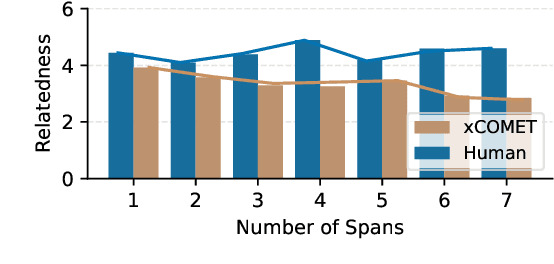

Abstract:While machine translation (MT) systems are achieving increasingly strong performance on benchmarks, they often produce translations with errors and anomalies. Understanding these errors can potentially help improve the translation quality and user experience. This paper introduces xTower, an open large language model (LLM) built on top of TowerBase designed to provide free-text explanations for translation errors in order to guide the generation of a corrected translation. The quality of the generated explanations by xTower are assessed via both intrinsic and extrinsic evaluation. We ask expert translators to evaluate the quality of the explanations across two dimensions: relatedness towards the error span being explained and helpfulness in error understanding and improving translation quality. Extrinsically, we test xTower across various experimental setups in generating translation corrections, demonstrating significant improvements in translation quality. Our findings highlight xTower's potential towards not only producing plausible and helpful explanations of automatic translations, but also leveraging them to suggest corrected translations.
Tower: An Open Multilingual Large Language Model for Translation-Related Tasks
Feb 27, 2024



Abstract:While general-purpose large language models (LLMs) demonstrate proficiency on multiple tasks within the domain of translation, approaches based on open LLMs are competitive only when specializing on a single task. In this paper, we propose a recipe for tailoring LLMs to multiple tasks present in translation workflows. We perform continued pretraining on a multilingual mixture of monolingual and parallel data, creating TowerBase, followed by finetuning on instructions relevant for translation processes, creating TowerInstruct. Our final model surpasses open alternatives on several tasks relevant to translation workflows and is competitive with general-purpose closed LLMs. To facilitate future research, we release the Tower models, our specialization dataset, an evaluation framework for LLMs focusing on the translation ecosystem, and a collection of model generations, including ours, on our benchmark.
 Add to Chrome
Add to Chrome Add to Firefox
Add to Firefox Add to Edge
Add to Edge